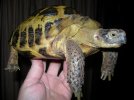My female just laid 4 eggs. She laid 3 last year, but they weren't fertile. I have them in a Hovabator at 88 degrees. I put them in containers with equal parts water and vermiculite. One egg has a hairline crack. The humidity may be a little high; it's around 90 percent. Last year, I had a difficult time keeping the temperature constant, so I added more water containers this time to see if it would help. Advice would be gratefully received as I really want to do this right.
Linda
Linda

